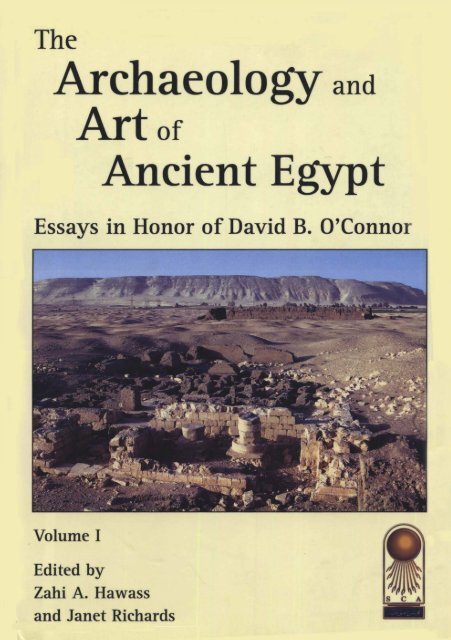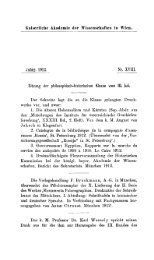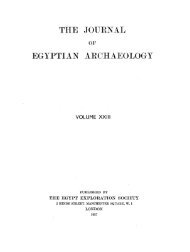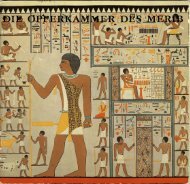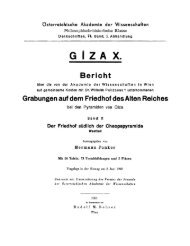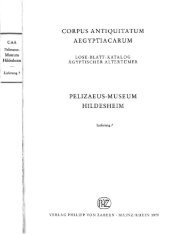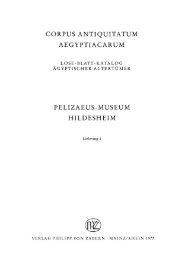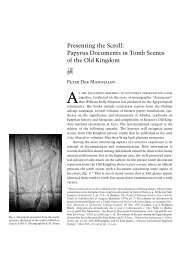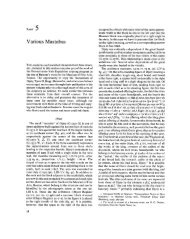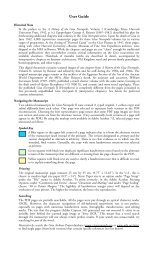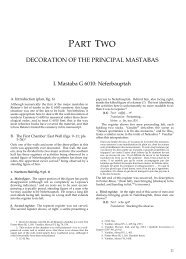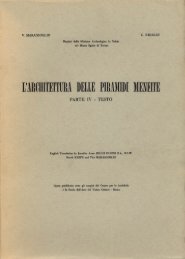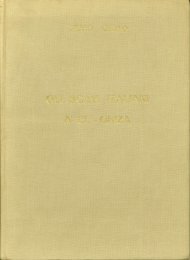Droughts, Famine and the Collapse of the Old Kingdom: Re ...
Droughts, Famine and the Collapse of the Old Kingdom: Re ...
Droughts, Famine and the Collapse of the Old Kingdom: Re ...
Create successful ePaper yourself
Turn your PDF publications into a flip-book with our unique Google optimized e-Paper software.
The<br />
Archaeology <strong>and</strong><br />
Artaf<br />
Ancient Egypt<br />
Essays in Honor <strong>of</strong> David B. O'Conno<br />
Volume I<br />
Edited by<br />
Zahi A. Hawass<br />
<strong>and</strong> Janet Richards
The<br />
Archaeology <strong>and</strong><br />
Artaf<br />
Ancient Egypt<br />
Essays in Honor <strong>of</strong> David B. O'Connor<br />
ANNALES DU SERVICE DES ANTIQUITES DE L'EGYPTE<br />
. CAHIER N° 36<br />
Volume I<br />
Edited by<br />
Zahi A. Hawass<br />
<strong>and</strong> Janet Richards<br />
PUBLICATIONS DU CONSEIL SUPREME DES ANTIQUITES DE L'EGYPTE
]<br />
Graphic Designer<br />
Lourie, Margaret A.<br />
Director <strong>of</strong> Printing<br />
Safwat, Amal<br />
(CASAE 36) 2007<br />
©.CONSEIL SUPREME DES AmIQUITES DE L'EGYPTE, LE CAIRE, 2007<br />
All rights reserved. No part <strong>of</strong> this publication may be reproduced,<br />
stored in a retrieval system, or transmitted in any form<br />
or by any means, electronic, mechanical, photocopying, recording,<br />
or o<strong>the</strong>rwise, without <strong>the</strong> prior written permission <strong>of</strong> <strong>the</strong><br />
publisher.<br />
Dar el Kutub No. 5576/2007<br />
ISBN-I0 977-437-241-7<br />
ISBN-13 987-977-437-241-4<br />
ISSN 5576/2007<br />
IMPRIMERIE DU CONSEIL SUPREME DES ANTIQUITES
Volume I<br />
Preface<br />
ZAHI A. HAWASS<br />
Acknowledgments<br />
List <strong>of</strong> Abbreviations<br />
David B. O'Connor: A Tribute<br />
H. S. SMITH<br />
An Archaeological Biography<br />
JANET RICHARDS<br />
Essays<br />
Contents<br />
MATIHEW DOUGlAS ADAMS, Household Silos, Granary Models, <strong>and</strong> Domestic<br />
Economy in Ancient Egypt<br />
xiii<br />
xv<br />
xvi<br />
xix<br />
xxi
Contents<br />
SUE D'AuRIA, The American Branch <strong>of</strong> <strong>the</strong> Egypt Exploration Fund 185<br />
ROSALIE DAVID, The lntemational Ancient Egyptian Mummy Tissue Bank:<br />
A 21 st Century Contribution to Paleo-pathological <strong>and</strong><br />
Paleo-pharmacological Studies 199<br />
DENISE DOXEY, A New <strong>Kingdom</strong> Pair Statue in <strong>the</strong> University <strong>of</strong><br />
Pennsylvania Museum 215<br />
GUNTER DREYER, Wer war Menes? 221<br />
KATHERINE EATON, Memorial Temples in <strong>the</strong> Sacred L<strong>and</strong>scape <strong>of</strong><br />
Nineteenth Dynasty Abydos: An Overview <strong>of</strong> Processional<br />
Routes <strong>and</strong> Equipment 231<br />
YAHIA EL-MASRY, The Ptolemaic Town (Ptolemais) 251<br />
AHMED EL-SAWY, The Necropolis <strong>of</strong> Ancient Terenouthis (Kom Abou Bellou) 267<br />
RICHARD A. FAZZlNI, Some Objects Found before <strong>the</strong> First Pylon <strong>of</strong> <strong>the</strong><br />
Mut Temple 277<br />
LAUREL FLENTYE, The Mastabas <strong>of</strong> Ankh-haf (G7510) <strong>and</strong> Akhe<strong>the</strong>tep<br />
<strong>and</strong> Meretites (G7650) in <strong>the</strong> Eastem Cemetery at Giza:<br />
A <strong>Re</strong>assessment 291<br />
RENEE FRIEDMAN, New Observations on <strong>the</strong> Fort at Hierakonpolis,<br />
Appendix by Dietrich Raue 309<br />
MELINDA HARTWIG, A ,Head <strong>of</strong> a Ramesside Queen from Abydos 337<br />
STEPHEN P. HARVEY, King Heqatawy: Notes on a Forgotten Eighteenth<br />
Dynasty Royal Name 343<br />
FEKRI A. HASSAN, <strong>Droughts</strong>, <strong>Famine</strong> <strong>and</strong> <strong>the</strong> <strong>Collapse</strong> <strong>of</strong> <strong>the</strong> <strong>Old</strong> <strong>Kingdom</strong>:<br />
<strong>Re</strong>-reading lpuwer 357<br />
ZAHI A. HAWASS, The Discovery <strong>of</strong> <strong>the</strong> Osiris Shaft at Giza 379<br />
ix
Contents<br />
COLIN A. HOPE, Egypt <strong>and</strong> 'Libya' to <strong>the</strong> End <strong>of</strong> <strong>the</strong> <strong>Old</strong> <strong>Kingdom</strong>:<br />
A View from Dakhleh Oasis 399<br />
SALIMA IKRAM, Animals in <strong>the</strong> Ritual L<strong>and</strong>scape at Abydos: A Synopsis 417<br />
RICHARD JASNOW, "Through Demotic Eyes:" On Style <strong>and</strong> Description<br />
in Demotic Narratives 433<br />
JANICE KAMRIN, Toward a New Database for <strong>the</strong> Egyptian Museum, Cairo 449<br />
Volume II<br />
NAGUIB KANAWATI, The Watchers/Dependents <strong>of</strong> Min <strong>of</strong> Akhmim<br />
in <strong>the</strong> <strong>Old</strong> <strong>Kingdom</strong><br />
BARRY KEMP, The Orientation <strong>of</strong> Burials at Tell el-Amama 21<br />
PETER LAcovARA, A Rishi C<strong>of</strong>fm from Giza <strong>and</strong> <strong>the</strong> Development <strong>of</strong><br />
This Type <strong>of</strong> Mummy Case 33<br />
ANTHONY LEAHY, Tomb <strong>Re</strong>lief Carving at Abydos in <strong>the</strong> Seventh Century BC 39<br />
MARK LEHNER AND FREYA SADARANGANI, Beds for Bowabs in a Pyramid City 59<br />
RONALD J. LEPROHON, "Opening" in <strong>the</strong> Pyramid Texts 83<br />
CHRISTINE LI LYQU 1ST, <strong>Re</strong>flections on Mirrors 95<br />
MICHELLE MARLAR, Sex as a Votive Offering at <strong>the</strong> Osiris Temple 111<br />
GEOFFREY T. MARTIN, The Early Dynastic Necropolis at North Saqqara:<br />
The Unpublished Excavations <strong>of</strong>W. B. Emery <strong>and</strong> C. M. Firth 121<br />
HEATHER LEE MCCARTHY, The Beit el-Wali Temple <strong>of</strong> Ramesses 11:<br />
A Cosmological Interpretation 127<br />
x
Contents<br />
ROBERT S. MERRILLEES, Egyptological Ramblings Down Under 147<br />
A. J. MILLS, Where Are We Going? 157<br />
ANGElA MILWARD-JONES, A Unique Design on a Faience Bowl from Abydos 161<br />
ELLEN F. MORRIS, On <strong>the</strong> Ownership <strong>of</strong> <strong>the</strong> Saqqara Mastabas <strong>and</strong> <strong>the</strong><br />
Allotment <strong>of</strong> Political <strong>and</strong> ldeological Power at <strong>the</strong> Dawn<br />
<strong>of</strong> <strong>the</strong> State 171<br />
KAROL MYSLIWIEC, The Scheme 2 x 4 in <strong>the</strong> Decoration <strong>of</strong><br />
<strong>Old</strong> <strong>Kingdom</strong> Tombs 191<br />
ADElA OPPENHEIM, Three Deities in Procession: A <strong>Re</strong>lief Block from <strong>the</strong><br />
Pyramid Complex <strong>of</strong> Senwosret 11 at Lahun in <strong>the</strong><br />
Metropolitan Museum <strong>of</strong> Art 207<br />
R. B. PARKINSON AND DETLEF FRANKE, A Song for Sarenput: Texts from<br />
Qubbet el-Hawa Tomb 36 219<br />
DIANA CRAIG PATCH, Third Intermediate Period Burials <strong>of</strong> Young<br />
Children at Abydos 237<br />
MARY-ANN POULS WEGNER, A Third lntermediate Period Burial<br />
'Ad Sanctos' at Abydos 257<br />
STEPHEN QUIRKE, Labour at Lahun 273<br />
ALI RADWAN, Concerning <strong>the</strong> Cult <strong>of</strong> Amenhotep 111 after His Death 289<br />
DONALD B. REDFORD, Some Toponyms <strong>and</strong> Personal Names <strong>Re</strong>lating<br />
to <strong>the</strong> Sea Peoples 299<br />
CAROL REDMOUNT, El Hibeh: A Brief Overview 303<br />
JANET RICHARDS, The Archaeology <strong>of</strong> Excavations <strong>and</strong> <strong>the</strong> Role <strong>of</strong> Context 313<br />
xi
Contents<br />
GAY ROBINS, The Decorative Program in <strong>the</strong> Tomb <strong>of</strong> Tutankhamun (KV 62) 321<br />
GERRY D. Scon, III, Two Ceremonial Palette Fragments in <strong>the</strong> Collection<br />
<strong>of</strong> <strong>the</strong> San Antonio Museum <strong>of</strong> Art 343<br />
STEPHAN JOHANNES SEIDLMAYER, People at Beni Hassan: Contributions to<br />
a Model <strong>of</strong> Ancient Egyptian Rural Society 351<br />
ALAA EL-DIN M. SHAHEEN, "Water Carrier" or <strong>the</strong> Like in <strong>the</strong> Ancient<br />
Egyptian Sources <strong>and</strong> lts <strong>Re</strong>semblance to Dilmun Glyptic Art 369<br />
JJ SHIRLEY, The Life <strong>and</strong> Career <strong>of</strong> Nebamun, <strong>the</strong> Physician <strong>of</strong><br />
<strong>the</strong> King in Thebes 381<br />
DAVID P. SILVERMAN AND JENNIFER HOUSER WEGNER, A Late Egyptian Story<br />
in <strong>the</strong> Penn Museum 403<br />
RAINER STADELMANN, King Huni: His Monuments <strong>and</strong> His Place in<br />
<strong>the</strong> History <strong>of</strong> <strong>the</strong> <strong>Old</strong> <strong>Kingdom</strong> 425<br />
CHIP VINCENT, lntemational Conservation Methodology,<br />
Practice <strong>and</strong> Ethics <strong>and</strong> Their Application at <strong>the</strong> American<br />
<strong>Re</strong>search Center in Egypt's Conservation Project at Abydos 433<br />
DEBORAH VISCHAK, ldentity in/<strong>of</strong> Elephantine: The <strong>Old</strong> <strong>Kingdom</strong> Tombs<br />
at Qubbet el Hawa 443<br />
JOSEF WEGNER, From Elephant-Mountain to Anubis-Mountain?<br />
A Theory on <strong>the</strong> Origins <strong>and</strong> Development <strong>of</strong> <strong>the</strong> Name Abdju 459<br />
xii
Preface<br />
E gyptology<br />
<strong>Droughts</strong>, <strong>Famine</strong> <strong>and</strong> <strong>the</strong> <strong>Collapse</strong><br />
<strong>of</strong> <strong>the</strong> <strong>Old</strong> <strong>Kingdom</strong>: <strong>Re</strong>-<strong>Re</strong>ading lpuwer<br />
Fekri A. Hassan<br />
University College London<br />
has benefited immensely from David O'Connor's commitment to an anthropological<br />
approach to ancient Egypt. Instead <strong>of</strong> an overemphasis on <strong>the</strong> complexities <strong>of</strong> deciphering<br />
texts that are luckily pursued by most Egyptologists, he has ventured into <strong>the</strong> domain <strong>of</strong> trying to<br />
make sense <strong>of</strong><strong>the</strong> results <strong>of</strong>such decipherments using anthropological insights. I first came across<br />
this when I was asked to review a book in which he had .come up with a novel approach to population<br />
<strong>and</strong> population growth in Ancient Egypt. Our paths crossed again when I began to investigate<br />
<strong>the</strong> probable causes <strong>of</strong> <strong>the</strong> collapse <strong>of</strong> <strong>the</strong> <strong>Old</strong> <strong>Kingdom</strong>. Combining archaeological research,<br />
not just as a means <strong>of</strong> digging for texts, with his anthropological perspective, O'Connor refuted<br />
traditional, ad hoc views on <strong>the</strong> end <strong>of</strong> <strong>the</strong> <strong>Old</strong> <strong>Kingdom</strong> in favor <strong>of</strong> a scenario that invoked an<br />
environmental disaster. I am pleased that this contribution lends support to his position.<br />
His ongoing work on <strong>the</strong> beginnings <strong>of</strong> Egyptian civilization at Abydos is already showing<br />
<strong>the</strong> fruits <strong>of</strong> systematic archaeological excavations <strong>and</strong> an anthropologically-informed approach<br />
to ancient Egypt.<br />
David O'Connor has also been active in promoting a cultural heritage approach to Egyptian<br />
archaeological resources, <strong>and</strong> is, indeed, one <strong>of</strong> a h<strong>and</strong>ful <strong>of</strong> Egyptologists <strong>and</strong> archaeologists<br />
who take this pr<strong>of</strong>oundly important matter seriously.<br />
Introduction<br />
For close to 500 years, <strong>and</strong> after <strong>the</strong> initial trials <strong>of</strong> founding a state society, Egypt went through<br />
a phase <strong>of</strong> gr<strong>and</strong>iose state-building, best exemplified by <strong>the</strong> monumental pyramids that extend<br />
over a stretch <strong>of</strong> 60 kilometers. The period was extremely dynamic with great achievements in<br />
state-craft involving <strong>the</strong> emergence <strong>of</strong> dedicated state functionaries, <strong>and</strong> bureaucrats. The sudden<br />
<strong>and</strong> abrupt demise <strong>of</strong> <strong>the</strong> centralized government that had developed during <strong>the</strong> <strong>Old</strong> <strong>Kingdom</strong> by<br />
<strong>the</strong> end <strong>of</strong> <strong>the</strong> reign <strong>of</strong> King Pepy II has been one <strong>of</strong> <strong>the</strong> most intriguing puzzles in <strong>the</strong> history <strong>of</strong><br />
357
Hassan<br />
ancient Egypt. Gardiner noted that <strong>the</strong> inscriptions from <strong>the</strong> First Intermediate Period (FlP), <strong>the</strong><br />
term collectively given to a span <strong>of</strong> time from c. 2185 to 2020 BCE, "constantly harp upon <strong>the</strong><br />
lack <strong>of</strong> grain, a lack which was due as much to <strong>the</strong> impossibility <strong>of</strong> undisturbed agriculture as to<br />
a succession <strong>of</strong> low Niles. It may be here noted that <strong>the</strong> deplorable state <strong>of</strong> Upper Egypt is clearly<br />
reflected in <strong>the</strong> clumsiness <strong>of</strong> its artistic efforts; evidently Egyptian civilization was at its lowest<br />
ebb" (GARDINER 1962: 11 I). It became common to refer to this period as a "dark age."<br />
<strong>Re</strong>cently, Franke (2001) traced <strong>the</strong> reference to <strong>the</strong> FIP as a "dark period" to Heinrich Brugsch.<br />
Franke acknowledges <strong>the</strong> breakdown <strong>of</strong> centralized administration during <strong>the</strong> First Intermediate<br />
Period, <strong>and</strong> notes that <strong>the</strong>re are indeed texts that mention famine <strong>and</strong> <strong>the</strong> loss <strong>of</strong> royal authority<br />
in tombs from Akhmim, el-Hagarsa <strong>and</strong> Hawawish. Never<strong>the</strong>less, he takes <strong>the</strong> view that conditions<br />
were not as bad as texts tell us. Texts, he argues, were ideologically biased. This is hardly justified<br />
since earlier texts do not refer to famine <strong>and</strong> loss <strong>of</strong> royal authority. One source <strong>of</strong> <strong>the</strong> confusion<br />
is that <strong>the</strong> term FlP lumps toge<strong>the</strong>r three stages; an initial stage <strong>of</strong> loss <strong>of</strong> royal authority <strong>and</strong> a<br />
collapse <strong>of</strong> centralized government which was short lived (20-30 years), followed by a phase <strong>of</strong><br />
struggle by various provincial leaders to re-establish order <strong>and</strong> claim royal authority. This phase<br />
entailed wars with "Asiatics" <strong>and</strong> internal war between contenders for <strong>the</strong> throne, which culminated<br />
in a final phase <strong>of</strong> re-establishing unity, leading to <strong>the</strong> emergence <strong>of</strong> <strong>the</strong> Middle <strong>Kingdom</strong>. The<br />
last two phases lasted for almost 180 years. The FIP was hardly a period <strong>of</strong> endless chaos, disorder,<br />
famine, <strong>and</strong> trouble, <strong>and</strong> it is important to restrict <strong>the</strong> term "dark age," if we must use it, to <strong>the</strong> first<br />
20-30 years <strong>of</strong> this period. The events <strong>of</strong> internal warfare, more in <strong>the</strong> spirit <strong>of</strong> <strong>the</strong> 100-year war<br />
in Europe, were not particularly bright. Never<strong>the</strong>less, that led to innovative technological achievements<br />
as well as novel systems <strong>of</strong> governance, state policies, ethics <strong>and</strong> legitimizing agenda. The<br />
unsettling political conditions are indicated, according to O'Connor (1974), by a six-fold increase<br />
in mortality in <strong>the</strong> Qau-Matmar region. In addition, excavations at Nag ed-Deir (from 1901 to<br />
1904 <strong>and</strong> again in 1912, 1913, <strong>and</strong> 1923) provide evidence for <strong>the</strong> "unsettled political situation"<br />
reflected in <strong>the</strong> presence <strong>of</strong> bows <strong>and</strong> o<strong>the</strong>r weapons. There is also gruesome evidence <strong>of</strong> warfare<br />
from <strong>the</strong> excavations at Deir el Bahari in 1911-193I(WINLOCK 1942: 123-127).<br />
In exploring <strong>the</strong> collapse <strong>of</strong><strong>the</strong> <strong>Old</strong> <strong>Kingdom</strong>, it has become almost customary to speak about<br />
<strong>the</strong> impoverishment <strong>of</strong> <strong>the</strong> resources <strong>of</strong> king Pepy II (SMITH 1962: 53) on account <strong>of</strong> immense<br />
constructions undertaken at royal expense <strong>and</strong> <strong>the</strong> innumerable funerary endowments exempt<br />
from taxation. However, such an account is based on no more than an intuitive speculation <strong>and</strong><br />
generalization from a few pieces <strong>of</strong> information.<br />
On this topic <strong>and</strong> o<strong>the</strong>r "social" explanations, O'Connor (1974: 17) remarked that <strong>the</strong> pyramids<br />
<strong>of</strong> <strong>the</strong> 4th Dynasty were in a sense an "aberration" that was never returned to even by <strong>the</strong><br />
strong kings <strong>of</strong> <strong>the</strong> 12th Dynasty. Those who adhere to <strong>the</strong> view that <strong>the</strong> collapse <strong>of</strong> <strong>the</strong> <strong>Old</strong><br />
<strong>Kingdom</strong> was precipitated by <strong>the</strong> actions <strong>of</strong> ambitious local governors forget that after <strong>the</strong> initial<br />
period <strong>of</strong>anarchy, it was hi<strong>the</strong>rto insignificant centers such as Herakleopolis <strong>and</strong> later Thebes that<br />
became politically dominant ra<strong>the</strong>r than <strong>the</strong> earlier provincial power centers, <strong>the</strong> dominance <strong>of</strong><br />
which might be expected to have been enhanced if <strong>the</strong> end <strong>of</strong> <strong>the</strong> <strong>Old</strong> <strong>Kingdom</strong> was caused by <strong>the</strong><br />
efforts <strong>of</strong> <strong>of</strong>ficials from <strong>the</strong>se power centers (O'CONNOR 1974: 16). <strong>Re</strong>cent excavations by Richards<br />
(2001) at Abydos have revealed how, in fat;t, <strong>the</strong> tombs <strong>of</strong> <strong>the</strong> king's high <strong>of</strong>ficials at Abydos<br />
were desecrated, robbed, <strong>and</strong> v<strong>and</strong>alized. We also lack concrete evidence for <strong>the</strong> presumed claim<br />
that larger temples emerged as strong competitors for power, as claimed by Butzer (1997: 258),<br />
nor do we have evidence that <strong>the</strong> marriage <strong>of</strong> one <strong>of</strong> Pepy's daughters to a prominent family in<br />
Upper Egypt was "a misguided effort to counterbalance <strong>the</strong> excessive power <strong>of</strong> <strong>the</strong> high <strong>of</strong>ficial<br />
bureaucracy in <strong>the</strong> capital."<br />
358
Hassan<br />
generate currents <strong>and</strong> eddies between one imagined social world <strong>and</strong> ano<strong>the</strong>r imagined world.<br />
This is well captured in "autopiscografia:', by <strong>the</strong> Portuguese Poet Fern<strong>and</strong>o Pessoa (HONIG <strong>and</strong><br />
BROWN 1986) where he explores <strong>the</strong> relatibifship between <strong>the</strong> poetic experience <strong>and</strong> truth simultaneously<br />
with <strong>the</strong> relationship between <strong>the</strong> poet <strong>and</strong> <strong>the</strong> reader, <strong>and</strong> is <strong>the</strong> subject <strong>of</strong> a great deal<br />
<strong>of</strong> current approaches to literature.<br />
Certainly <strong>the</strong>re can be an infinite number <strong>of</strong> readings <strong>of</strong> <strong>the</strong> same text, including several by<br />
<strong>the</strong> same reader depending on <strong>the</strong> context <strong>and</strong> purpose <strong>of</strong> <strong>the</strong> reading. In <strong>the</strong> present context, I<br />
am concerned with <strong>the</strong> historical <strong>and</strong> sociocultural significance <strong>of</strong> <strong>the</strong> work-a subject that may<br />
benefit from <strong>the</strong> sociocultural approaches to literature engendered by <strong>the</strong> French <strong>Re</strong>volution<br />
(BARBERIS 2002). Parkinson does recognize that "literature was a culturally central artifact in <strong>the</strong><br />
Middle <strong>Kingdom</strong>" <strong>and</strong> proposes that <strong>the</strong> texts affirmed loyalist values, <strong>and</strong> that many <strong>of</strong> <strong>the</strong>m<br />
were didactic (PARKINSON 1997: 14). But, <strong>the</strong> main question is how does this literature differ from<br />
that <strong>of</strong> <strong>Old</strong> <strong>Kingdom</strong> writings <strong>and</strong> why? Ipuwer's poem should perhaps be considered as <strong>the</strong><br />
French literary works after <strong>the</strong> revolution <strong>of</strong> 1789. The French needed literary works that celebrated<br />
new values <strong>and</strong> reflected upon <strong>the</strong> new realities <strong>of</strong> society <strong>and</strong> <strong>of</strong> individual ambitions.<br />
Authors examined <strong>the</strong>ir own lives <strong>and</strong> suffered <strong>the</strong> pain <strong>of</strong> <strong>the</strong> imperfections that fell short from<br />
<strong>the</strong> ideals. Writing became reflective <strong>and</strong> persuasive. To underst<strong>and</strong> <strong>the</strong> literature <strong>of</strong> this period,<br />
Germaine de Stael, writing in <strong>the</strong> 19th century, called for a <strong>the</strong>ory <strong>of</strong> <strong>the</strong> particularity <strong>of</strong> <strong>the</strong> text<br />
within <strong>the</strong> social <strong>and</strong> historical context <strong>of</strong> its motives, objectives, <strong>and</strong> consequences (BARBERIS<br />
1987). Ipuwer,like Balzac, wrote in <strong>the</strong> light <strong>of</strong> what he believed to be two pillars <strong>of</strong>society; kingship<br />
<strong>and</strong> religion, but <strong>the</strong> texts <strong>of</strong> both <strong>of</strong> <strong>the</strong>m could not be reduced to a conservative reflection<br />
by royalists. Their texts were imbued with historically constituted ideals <strong>and</strong> -events, but <strong>the</strong>ir<br />
words had <strong>the</strong> seeds <strong>of</strong> a new future.<br />
From a sociocultural perspective, whe<strong>the</strong>r Ipuwer's text was addressed to a certain king or to<br />
a generalized representative <strong>of</strong> authority is irrelevant because his work denounces disorder <strong>and</strong><br />
calls for stability <strong>and</strong> order through actions. In this respect, <strong>the</strong> search by T. S. Eliot for stability<br />
<strong>and</strong> stillness though traditionalism (MAxWELL 1961: 208-212) is revealing. His Waste L<strong>and</strong> may<br />
st<strong>and</strong> for lpuwer's own. Eliot reaches for spiritual salvation, lpuwer calls for action. But although<br />
he called for "restoration," his text was far richer, thicker, <strong>and</strong> more diversified to be merely a<br />
loyalist treatise. His dissent, scepticism, <strong>and</strong> courage reveal that his "poetry" was not a means<br />
to transform an imperfect world into perfect speech (PARKINSON 1997: 17), but to transform an<br />
imperfect world by perfect speech.<br />
Ipuwer's Text: A Literary History<br />
The analysis <strong>of</strong> an ancient text is a daunting exercise (ASSMANN <strong>and</strong> BWMENlliALI999; LICfITHEIM<br />
1988, 1996; LOPRIENO 1996; PARKINSON 1991, 1996, 1997,2002; QUIRKE 1996). Ipuwer's text is especially<br />
difficult perhaps because it is complex, thick with details <strong>and</strong> generalizations with shifting<br />
modalities <strong>and</strong> expressions. The titles <strong>and</strong> appellations given to by Egyptologists as "admonitions,"<br />
"lamentations," or "loyalist propag<strong>and</strong>a" (LICHTHEIM 1973) have distracted both from its<br />
manifold literary merits <strong>and</strong> its universal [trans-cultural <strong>and</strong> trans-temporal] appeal that makes<br />
it such compelling <strong>and</strong> gripping reading. Moreover, treating this exceptional work as no more<br />
than a literary fiction has led some renowned Egyptologists to negate its historical value. The<br />
correspondence between descriptions by AI-Baghdadi <strong>of</strong> <strong>the</strong> events associated with <strong>the</strong> famine<br />
<strong>of</strong> 1200-1202 CE <strong>and</strong> Ipuwer, separated by a huge span <strong>of</strong> time <strong>and</strong> from different cultures <strong>and</strong><br />
social position, leaves little doubt that Ipuwer was ei<strong>the</strong>r an eyewitness to <strong>the</strong> famine or that he<br />
had first h<strong>and</strong> access to historical material on which he based his Work in <strong>the</strong> same way that<br />
362
<strong>Droughts</strong>, <strong>Famine</strong> <strong>and</strong> <strong>the</strong> <strong>Collapse</strong> <strong>of</strong> <strong>the</strong> <strong>Old</strong> <strong>Kingdom</strong><br />
AI-Maqrizi writjng in 1405 CE used <strong>the</strong> information fr6m AI-Baghdadi <strong>and</strong> o<strong>the</strong>rs in his opus on<br />
famine <strong>and</strong> eCOl)omy in medieval Egypt (ALLOUCHE 1994).<br />
Even if Ipuwer lived at <strong>the</strong> end <strong>of</strong> <strong>the</strong> 12th Dynasty, c. 1900-1800 BCE (PARKINSON 1997:<br />
166), <strong>the</strong> famine would have occurred 260-370 years earlier compared with 200 years separating<br />
AI-Maqrizi from AI-Baghdadi. The similarity is interesting because <strong>the</strong> impact <strong>of</strong> <strong>the</strong> famine<br />
described by AI-Baghdadi was so severe that <strong>the</strong> information he provided was preserved by later<br />
historians <strong>and</strong> commentators on medieval Egypt. As AI-Maqrizi depended on written historical<br />
accounts, Ipuwer's work, if it were written much later than <strong>the</strong> events it described, would<br />
have also depended on earlier sources sufficiently close to <strong>the</strong> event to allow him to give such<br />
a detailed <strong>and</strong>, by analogy with medieval famines, fairly accurate depiction. Surely <strong>the</strong> severity<br />
<strong>of</strong> <strong>the</strong> famine <strong>and</strong> its consequences made <strong>the</strong> events <strong>of</strong> <strong>the</strong> First Intermediate Period memorable.<br />
The recurrence <strong>of</strong> occasional famines during <strong>the</strong> early part <strong>of</strong> <strong>the</strong> Middle <strong>Kingdom</strong> would have<br />
sustained <strong>the</strong> memory <strong>of</strong> <strong>the</strong> great famine. Similarly, AI-Maqrizi's account was prompted by<br />
famines in his own lifetime. Moreover, AI-Maqrizi's work was not a dispassionate historical<br />
anecdote. AI-Maqrizi aimed to deliver a message concerning <strong>the</strong> importance <strong>of</strong> good government<br />
when people are hit by famine. He was concerned with greed, corruption, inflation <strong>of</strong> prices, <strong>and</strong><br />
<strong>the</strong> debasement <strong>of</strong> <strong>the</strong> currency as complicating factors. Likewise, Ipuwer might have had his<br />
political motives.<br />
Ipuwer's work has been considered <strong>of</strong> <strong>the</strong> same genre as that <strong>of</strong> Neferty (LICHIHEIM 1973: 149),<br />
to whom we referred when we dealt with Ankhtifi's reference to famine before. Neferty's work is<br />
a straightforward piece <strong>of</strong> political writing. It is shorter <strong>and</strong> direct, which led Lich<strong>the</strong>im to suggest<br />
that Ipuwer's longer <strong>and</strong> more repetitive work was a "late comer" in <strong>the</strong> genre <strong>of</strong> "national<br />
distress" <strong>and</strong> <strong>of</strong> purely literary inspiration. This is hardly justifiable since <strong>the</strong>re is no rule for<br />
dating texts sequentially on <strong>the</strong> basis <strong>of</strong> <strong>the</strong>ir length <strong>and</strong> repetitiveness. In addition, we do not<br />
know <strong>the</strong> original form <strong>of</strong> <strong>the</strong> texts-both Neferty's <strong>and</strong> Ipuwer's texts survive as copies from <strong>the</strong><br />
New <strong>Kingdom</strong>, <strong>the</strong> 18th <strong>and</strong> 19th Dynasty respectively.<br />
In rejecting <strong>the</strong> historical content <strong>of</strong> Ipuwer's work, Lich<strong>the</strong>im relied on an analysis by <strong>the</strong><br />
Russian historian S. Luria (1929), whose aim was to provide an historical analysis <strong>of</strong> <strong>the</strong> mythic<br />
<strong>and</strong> mental [cognitive] structure <strong>of</strong> <strong>the</strong> work.<br />
Ipuwer's richness in <strong>the</strong> details <strong>of</strong> famine <strong>and</strong> physical suffering compared with Neferty's <strong>and</strong><br />
Ankhu's greater emphasis on reversal <strong>of</strong> fortune, social upheaval <strong>and</strong> moral crisis in my opinion<br />
places Ipuwer closer to <strong>the</strong> beginning <strong>of</strong> <strong>the</strong> 12th Dynasty if not earlier. Later derivative works<br />
had <strong>the</strong> benefit <strong>of</strong> his rich opus to create shorter versions with a single specific objective.<br />
According to Ward (1999), Ipuwer's work belongs to <strong>the</strong> late <strong>Old</strong> <strong>Kingdom</strong>. He rejects <strong>the</strong><br />
assertion by J. van Seters (1964), who suggested a late 13th Dynasty date, by pointing out that<br />
<strong>the</strong> text is a copy made during <strong>the</strong> New <strong>Kingdom</strong> <strong>and</strong> it is most likely that copyists could slip<br />
into using current words for more archaic or ,disused words. They could also do that in editing<br />
texts for contemporary audiences, which would make <strong>the</strong> text appear much later than its original<br />
copy (VAN DE WALLE 1948; DONADONI 1968). However, Franke, Parkinson, <strong>and</strong> Quirke tend to<br />
assign Ipuwer's work to <strong>the</strong> late Middle <strong>Kingdom</strong> (FRANKE 2001; PARKINSON 1997: 166, Quirke:<br />
personal communication 2003) on <strong>the</strong> basis <strong>of</strong> various internal criteria such as institutions <strong>and</strong><br />
titles cited in <strong>the</strong> text. However, this might have been a feature <strong>of</strong> a late Middle <strong>Kingdom</strong> copy<br />
<strong>of</strong> <strong>the</strong> original (see below).<br />
Ipuwer was perhaps a young man by <strong>the</strong> end <strong>of</strong> Pepy II's reign; if he was 20 years old at that<br />
time, he would have been 45 by <strong>the</strong> beginning <strong>of</strong> <strong>the</strong> 9th Dynasty, having lived through <strong>the</strong> terrible<br />
events <strong>of</strong> <strong>the</strong> 7th <strong>and</strong> 8th Dynasties <strong>and</strong> witnessed <strong>the</strong> tragic collapse [from his own point<br />
363
<strong>Droughts</strong>, <strong>Famine</strong> <strong>and</strong> <strong>the</strong> <strong>Collapse</strong> <strong>of</strong> <strong>the</strong> <strong>Old</strong> <strong>Kingdom</strong><br />
expressed his view <strong>of</strong> life <strong>and</strong> has since injected his text into life. Although. as philosopher Karl<br />
Jaspers realized. no one can escape his historical position; within <strong>the</strong> limits <strong>and</strong> conditions <strong>of</strong><br />
each world-view "Being" itself is encountered (SEIDLMAYER 2000: 127-8).<br />
Ipuwer's Annals<br />
The deep philosophical aspects <strong>of</strong> Ipuwer's work <strong>and</strong> his yearning for stability under a strong<br />
monarch do not. however. detract from his detailed account <strong>of</strong> <strong>the</strong> processes that led to <strong>the</strong> demise<br />
<strong>of</strong> kingship <strong>and</strong> <strong>the</strong> loss <strong>of</strong> central authority. The key factor in <strong>the</strong> collapse <strong>of</strong> <strong>the</strong> monarchy was<br />
<strong>the</strong> loss <strong>of</strong> revenues from <strong>the</strong> provinces as famine became widespread because <strong>of</strong> persistently low<br />
Nile floods. Conditions worsened as peasants died in large numbers thus reducing <strong>the</strong> size <strong>of</strong> <strong>the</strong><br />
labour force. Even when good floods returned. agricultural productivity was low. The control <strong>of</strong><br />
<strong>the</strong> Memphite rulers was minimal. Their strongholds in <strong>the</strong> provinces also collapsed as famine <strong>and</strong><br />
despair led peasants to riot. loot. <strong>and</strong> murder. Tombs <strong>and</strong> temples were violated. Tax records <strong>and</strong><br />
government documents were destroyed. As riots <strong>and</strong> violence spread. <strong>the</strong> administrative structure<br />
<strong>of</strong> <strong>the</strong> country was ruined. This fur<strong>the</strong>r undermined <strong>the</strong> possibility <strong>of</strong> collecting <strong>and</strong> delivering revenues<br />
to <strong>the</strong> royal household. In places. thugs took charge <strong>of</strong> towns <strong>and</strong> cities. Enmity. greed. <strong>and</strong><br />
aggression extended even to family members. The Memphite kings. weakened <strong>and</strong> impoverished.<br />
were unable to repel <strong>the</strong> encroachment <strong>of</strong> Bedouins in <strong>the</strong> eastern Delta. In almost two decades it<br />
appeared that all was lost. Peasants. who survived. were demoralized <strong>and</strong> dilapidated. They had no<br />
protection against those who managed to accumulate power <strong>and</strong> fortune in those tumultuous times.<br />
The noblemen lost <strong>the</strong>ir power-base <strong>and</strong> <strong>the</strong>ir fortunes-some were reduced to abject poverty <strong>and</strong><br />
degraded beyond <strong>the</strong>ir imagination. The restoration <strong>of</strong> kingship as a means to re-establish order.<br />
stability <strong>and</strong> peace became a tantalizing dream. <strong>and</strong> for some even a necessity for survival.<br />
The reading <strong>of</strong> Ipuwer's text as a literary work <strong>of</strong> little historical factuality robs <strong>the</strong> reader <strong>of</strong><br />
appreciating <strong>the</strong> analytical framework used by Ipuwer to explain <strong>the</strong> collapse <strong>of</strong><strong>the</strong> <strong>Old</strong> <strong>Kingdom</strong>.<br />
This collapse <strong>of</strong><strong>the</strong> government <strong>of</strong> <strong>the</strong> <strong>Old</strong> <strong>Kingdom</strong> was not a result <strong>of</strong> a social revolution. It was<br />
a period <strong>of</strong> breakdown <strong>of</strong>control <strong>and</strong> chaos: The following phase <strong>of</strong>reclaiming order <strong>and</strong> re-instituting<br />
<strong>the</strong> monarchy entailed a religious reformation <strong>and</strong> a re-interpretation <strong>and</strong> re-packaging <strong>of</strong><br />
"divine" kingship. The outcome was "revolutionary" in its consequences. but it was nei<strong>the</strong>r due to<br />
an organized peasant revolution. nor <strong>the</strong> result <strong>of</strong> a political movement that aimed to overthrow<br />
<strong>the</strong> ruling kings <strong>of</strong> Memphis by power-hungry nomarchs. Egyptologist Stephan Seidlmayer is<br />
specifically clear on this point (SEIDLMAYER 2000: 127-8):<br />
It is important to realize... that <strong>the</strong> end <strong>of</strong> <strong>the</strong> <strong>Old</strong> <strong>Kingdom</strong> was not brought about by <strong>the</strong><br />
increasing power <strong>of</strong> <strong>the</strong> great families <strong>of</strong> monarchs. In fact. a new line <strong>of</strong> local magnates<br />
appeared during <strong>the</strong> First Intermediate Period.<br />
The situation during <strong>the</strong> initial phase <strong>of</strong> famine. plunder. violence <strong>and</strong> breakdown in governmental<br />
control was aggravated by an increasing presence <strong>of</strong> Asiatic marauders from <strong>the</strong> desert<br />
l<strong>and</strong>s east <strong>of</strong> Egypt. who became well established at a time when <strong>the</strong> ruling kings had nei<strong>the</strong>r <strong>the</strong><br />
economic means to raise an army nor <strong>the</strong> political structure to mobilize conscripts from a country<br />
tom by famine. internal fighting. <strong>and</strong> a breakdown in <strong>the</strong> lines <strong>of</strong> comm<strong>and</strong>.<br />
Ipuwer portrays <strong>the</strong> destruction <strong>of</strong> <strong>the</strong> monarchy as follows (LICHTHEIM 1973: 149-163):<br />
See. one buried as hawk! falcon is ...!devoid <strong>of</strong> biers! (7.2)<br />
What <strong>the</strong> pyramid hid is empty. (7.2)<br />
365
<strong>Droughts</strong>, <strong>Famine</strong> <strong>and</strong> <strong>the</strong> <strong>Collapse</strong> <strong>of</strong> <strong>the</strong> <strong>Old</strong> <strong>Kingdom</strong><br />
Mystique <strong>of</strong> kingship divulged:<br />
Lo, those who were entombed are cast on high ground, (4,4=6,14)<br />
Embalmers' secrets are thrown away. (4,4)<br />
Lo, those who were entombed are cast on high ground, (4,4=6,14)<br />
Embalmers' secrets are thrown away. (4,4=6,14)<br />
The secrets in it are laid bare. (6,6)<br />
Lo, magic spells are divulged, Spells are made worthless through being repeated by people.<br />
(6,6-7)<br />
Lo, <strong>the</strong> beggar comes to <strong>the</strong> place <strong>of</strong> <strong>the</strong> Nine Gods, (6,11)<br />
The /erstwhile/ procedure <strong>of</strong> <strong>the</strong> House <strong>of</strong> Thirty is laid bare/divulged. (6,11)<br />
Lo, <strong>the</strong> great council chamber is invaded, (6,12)<br />
Beggars come <strong>and</strong> go in <strong>the</strong> great mansions. (6,12)<br />
The secrets <strong>of</strong> Egypt's kings are bared/divulged/. (7,5-6)<br />
The collapse <strong>of</strong> <strong>the</strong> <strong>Old</strong> <strong>Kingdom</strong> was to a great extent a result <strong>of</strong> breakdown <strong>of</strong> specific<br />
administrative mechanisms <strong>and</strong> functions listed by Ipuwer as follows:<br />
Destruction <strong>of</strong> <strong>Re</strong>cords:<br />
Lo, <strong>the</strong> private/council/ chamber, its books/writings are stolen, (6,5)<br />
Lo, <strong>of</strong>fices are opened, (6,7)<br />
Their records stolen, (6,7)<br />
Lo, [scribes] are slain, (6,8)<br />
Their writings stolen, (6,8)<br />
Lo, <strong>the</strong> scribes <strong>of</strong> <strong>the</strong> l<strong>and</strong>-register, Their books are destroyed, (6,9)<br />
[See, he who recorded] <strong>the</strong> harvest knows nothing about it (9,7),<br />
Destruction <strong>of</strong> administrative structure:<br />
Every town says, "Let us expel our rulers."/Let us suppress <strong>the</strong> powerful among us. (2,7-8)<br />
Lo, <strong>the</strong> ship <strong>of</strong> <strong>the</strong> South founders/broken up, (2,11) Towns are ravaged/destroyed, Upper<br />
Egypt became wastel<strong>and</strong>. (2,11)<br />
The nomes are destroyed, (3,1)<br />
Those who were in <strong>the</strong> god's bark are yoked [to it]. (3,6)<br />
Lo, <strong>the</strong> whole Delta cannot be seen, (4,6)<br />
Lower Egypt puts trust in trodden roads. (4,6)<br />
, <strong>the</strong> chiefs <strong>of</strong> <strong>the</strong> l<strong>and</strong> flee, They have no purpose because <strong>of</strong> want --- (8,14)<br />
See, all <strong>the</strong> ranks, <strong>the</strong>y are not in <strong>the</strong>ir place, Like a herd that roams without a herdsman. (9,2)<br />
See, cattle stray with none to bring <strong>the</strong>m back, Everyone fetches for himself <strong>and</strong> br<strong>and</strong>s with<br />
his name. (9,2-3)<br />
He who was a does his own err<strong>and</strong>s. See, <strong>the</strong> mighty <strong>of</strong> <strong>the</strong> l<strong>and</strong> are not reported<br />
to, (9,5-6)<br />
Breakdown <strong>of</strong> law <strong>and</strong> order:<br />
Lo, <strong>the</strong> laws <strong>of</strong> <strong>the</strong> chamber are thrown out, (6,9-10)<br />
Men walk on <strong>the</strong>m in <strong>the</strong> streets; (6,10)<br />
Beggars/poor men/ tear <strong>the</strong>m up in <strong>the</strong> alleys. (6,10-11)<br />
Lo, --- throughout <strong>the</strong> l<strong>and</strong>, The strong man sends to everyone (5,10),<br />
367
Hassan<br />
Conuption:<br />
Lo, [Right] is <strong>the</strong> l<strong>and</strong> in name, St<strong>and</strong>ing on it one does wrong (5,3)<br />
See, <strong>the</strong> serfs eat beef/ Behold, 'priests' transgress with <strong>the</strong> cattle <strong>of</strong> <strong>the</strong> poor, The paupers<br />
_m_ (8,11)<br />
See, <strong>the</strong> serfs eat geese/Behold. 'priests' transgress with geese, Offered <strong>the</strong> gods in place<br />
<strong>of</strong> cattle. (8,12)<br />
The collapse <strong>of</strong><strong>the</strong> <strong>Old</strong> <strong>Kingdom</strong> entailed much more than a changeover <strong>of</strong> a political regime.<br />
The collapse was aggravated by <strong>the</strong> emergence <strong>of</strong> dilapidating, antisocial attitudes. Fortunately,<br />
Ipuwer provides us with a perspective on <strong>the</strong> disruptive anti-social attitudes bred by <strong>the</strong> deterioration<br />
in living conditions; <strong>the</strong> violence, <strong>the</strong> countless deaths, civil disorder, <strong>and</strong> loss <strong>of</strong> fortunes.<br />
These anomic social disorders included enmity, greed, aggression, <strong>and</strong> dissolution <strong>of</strong> family<br />
values <strong>and</strong> bonds.<br />
Enmity:<br />
A man regards his son as his enemy. (1,5)<br />
Hostility ----- ano<strong>the</strong>r. (1,6)<br />
The children <strong>of</strong> magnates are ejected into <strong>the</strong> street, (6,12) (see also LICHTHEIM 1973,<br />
p. 155)<br />
He who puts his bro<strong>the</strong>r in <strong>the</strong> ground is everywhere. (2,13-14)<br />
The great do not mingle with <strong>the</strong>ir people []. (2,5)<br />
Greed:<br />
Lo, men's slaves, <strong>the</strong>ir hearts are greedy [sad] (2,5)<br />
Aggression:<br />
Lo, hearts are violent, (2,5)<br />
Dissolution <strong>of</strong> Family Morality:<br />
A man strikes his maternal bro<strong>the</strong>r. (5,11)<br />
See, a man is slain by <strong>the</strong> side <strong>of</strong> his bro<strong>the</strong>r, who ab<strong>and</strong>ons him to save himself. (9,3)<br />
From an intellectual point <strong>of</strong> view Ipuwer regards as one <strong>of</strong> <strong>the</strong> main ills <strong>of</strong> society <strong>the</strong> lack<br />
<strong>of</strong> guidance by wise men, whose words are no longer heeded:<br />
<strong>the</strong>re is no man <strong>of</strong> yesterday. (2,2). (2,14)<br />
The breakdown in <strong>the</strong> moral fabric <strong>of</strong> society <strong>and</strong> <strong>the</strong> heart-wrenching horrors witnessed by<br />
those who lived were traumatic as one may ga<strong>the</strong>r from Ipuwer's account. The combination <strong>of</strong><br />
antisocial attitudes <strong>and</strong> <strong>the</strong> emotional disorders ranging from sadness to utter despondency contributed<br />
significantly to <strong>the</strong> worsening <strong>of</strong> conditions as people became listless. Many remained<br />
"silent" as killing, conuption, <strong>and</strong> destruction raged across <strong>the</strong> country.<br />
The brewers u sad. (1,5-6) The man <strong>of</strong> character [<strong>the</strong> virtuous man] walks in mourning on<br />
account <strong>of</strong> <strong>the</strong> state <strong>of</strong> <strong>the</strong> l<strong>and</strong>. (1,8)<br />
Lo, <strong>the</strong> face is pale -----(1,9)<br />
368
<strong>Droughts</strong>, <strong>Famine</strong> <strong>and</strong> <strong>the</strong> <strong>Collapse</strong> <strong>of</strong> <strong>the</strong> <strong>Old</strong> <strong>Kingdom</strong><br />
Lo, <strong>the</strong> face is pale, (2,2)<br />
Lo, merriment /laughter/ has ceased, is made no more, (3,13-14)<br />
Groaning is throughout <strong>the</strong> l<strong>and</strong>, mingled with laments. (3,14)<br />
Lo, all beasts, <strong>the</strong>ir hearts weep, Cattle bemoan <strong>the</strong> state <strong>of</strong> <strong>the</strong> l<strong>and</strong>. (5,5)<br />
One says, "Don't walk here, <strong>the</strong>re's a net," People flap like fish, (42c) The scared does not<br />
discern it in his fright. (2,12-13)<br />
Lo, terror kills; (5,7)<br />
<strong>the</strong> frightened says..... (5,7)<br />
Lo, great <strong>and</strong> small , "I wish I were dead," Little children say, "He should not have made<br />
me live!" (4,2-3)<br />
Ipuwer masterfully interweaves specific details <strong>and</strong> figurative metaphors with overall generalizations,<br />
leading us back <strong>and</strong> forth from <strong>the</strong> microscopic view <strong>of</strong> events, from <strong>the</strong> emotive<br />
images, to a bird's eye view <strong>of</strong> <strong>the</strong> country as a whole <strong>and</strong> <strong>of</strong> <strong>the</strong> spirit <strong>of</strong> <strong>the</strong> time, what <strong>the</strong><br />
Germans call Zeitgeist-<strong>the</strong> overall condition <strong>of</strong> Egypt <strong>and</strong> its state <strong>of</strong> mind. Egypt was injured, its<br />
fortunes overturned, people no longer guided by <strong>the</strong>ir past, confused <strong>and</strong> distraught, subdivided,<br />
<strong>and</strong> weak. All is ruin.<br />
«The l<strong>and</strong> is injured>, (2,12)<br />
Lo, all beasts, <strong>the</strong>ir hearts weep, Cattle bemoan <strong>the</strong> state <strong>of</strong> <strong>the</strong> l<strong>and</strong>. (5,5)<br />
Lo, [] from noise/because <strong>of</strong> noise, noise is not [...] in years <strong>of</strong> noise, <strong>and</strong><br />
<strong>the</strong>re is no end <strong>of</strong> noise, No in years <strong>of</strong> shouting, No .<br />
(4,1-,2)<br />
Lo, gone is what yesterday was seen, (4,5)<br />
The l<strong>and</strong> is left to its weakness like a cutting <strong>of</strong> flax (4,5)<br />
All say, "We don't know what has happened in <strong>the</strong> l<strong>and</strong>." (2,3)<br />
The affairs <strong>of</strong> <strong>the</strong> people have gone to ruin/All is ruin! 0,13 = 9,5-6)<br />
The disastrous events <strong>and</strong> <strong>the</strong> array <strong>of</strong> mishaps from starvation to social anarchy with all<br />
<strong>the</strong> sorrows <strong>and</strong> emotional anguish <strong>the</strong>y created, led to different responses. We can detect <strong>the</strong>se<br />
responses by analyzing <strong>the</strong> words <strong>of</strong> Ipuwer <strong>and</strong> related works in which <strong>the</strong> disaster <strong>of</strong> <strong>the</strong> First<br />
Intermediate Period was <strong>the</strong> main subject. We can do this by attempting to uncover <strong>the</strong> fundamental<br />
mental "formula," or [cognitive] schema, that inspired <strong>and</strong> structured <strong>the</strong> generation <strong>of</strong><br />
<strong>the</strong> various statements in <strong>the</strong> work. By looking at <strong>the</strong> major "<strong>the</strong>mes," we can detect three core<br />
issues that capture <strong>the</strong> overall content <strong>of</strong> <strong>the</strong> work. These <strong>the</strong>mes (regardless <strong>of</strong> how <strong>the</strong>y appear<br />
in text) may be expressed as follows:<br />
(I) Ruination [leads to]<br />
(II) Distress [dem<strong>and</strong>s action]<br />
(lll) Action [by king leading to] restoration <strong>of</strong> order.<br />
We may thus abbreviate Ipuwer's long work into <strong>the</strong> following lines:<br />
(I) All say, "We don't know what has happened in <strong>the</strong> l<strong>and</strong>." (2,3)<br />
The affairs <strong>of</strong> <strong>the</strong> people have gone to ruin/All is ruin! (9,5-6)<br />
(II) The man <strong>of</strong> character [<strong>the</strong> virtuous man] walks in mourning on account <strong>of</strong> <strong>the</strong> state <strong>of</strong> <strong>the</strong><br />
369
Hassan<br />
l<strong>and</strong>. (I,8)<br />
That is our fortune/fate/ (3,13)<br />
What shall/can we do about it? (3,13)<br />
(III) [Destroy <strong>the</strong> foes <strong>of</strong>] that noble [residence], rich in <strong>of</strong>fices. Lo, _nn (IO,7-8). There are plenty<br />
<strong>of</strong> fighters to repel <strong>the</strong> Bowmen. Is it Libyans? Then we will tum <strong>the</strong>m back (I4, 13-14).<br />
<strong>Re</strong>member <strong>the</strong> erecting <strong>of</strong> flagstaffs, <strong>the</strong> carving <strong>of</strong> <strong>of</strong>fering stones; <strong>the</strong> priest cleansing <strong>the</strong><br />
chapels, <strong>the</strong> temple whitewashed like milk; sweetening <strong>the</strong> fragrance <strong>of</strong> <strong>the</strong> sanctuary, setting<br />
up <strong>the</strong> bread-<strong>of</strong>ferings (11,3-4).<br />
By comparison, Neferty's work could be rendered in <strong>the</strong> same manner as follows (LICIffilEIM 1973:<br />
139-144):<br />
(I) The l<strong>and</strong> is quite perished, no one is left (1.24)<br />
(II) Bewail this l<strong>and</strong> from which you have sprung! (20)<br />
Rise against that what is before you (22)<br />
(III) A king will come from <strong>the</strong> South (57-58)<br />
<strong>Re</strong>bels [will fall] to his wrath (64)<br />
Asiatics will fall to his sword (63)<br />
Then order will return to its seat (68)<br />
Neferty's work belongs to <strong>the</strong> same "schema" as Ipuwer's <strong>and</strong> his response to <strong>the</strong> chaos <strong>and</strong><br />
distress is to prophesize <strong>the</strong> coming <strong>of</strong> a king who will take <strong>the</strong> action called for by Ipuwer.<br />
However, a variant <strong>of</strong> that schema does not call for action, <strong>and</strong> Part III <strong>of</strong> <strong>the</strong> schema is no more<br />
than an expression <strong>of</strong>impotence against <strong>the</strong> arrows <strong>of</strong> fate, as in <strong>the</strong> work by Khakhepeme-Sonb,<br />
called Ankhu, dated to Sesostris II or shortly <strong>the</strong>reafter. It survives in a copy from <strong>the</strong> middle <strong>of</strong><br />
<strong>the</strong> 18th Dynasty (LICIffilEIM 1973: 145-149):<br />
(I) The l<strong>and</strong> breaks up, is destroyed<br />
Becomes [a wastel<strong>and</strong>] (rt 10)<br />
(II) There is mourning everywhere<br />
The whole l<strong>and</strong> is in great distress (rt 11)<br />
(III) The sufferer lacks strength to save himself (vs. 4)<br />
In yet ano<strong>the</strong>r version, <strong>the</strong> "Dispute between a Man <strong>and</strong> His Ba" dating from <strong>the</strong> 12th Dynasty<br />
Part III expresses <strong>the</strong> view that death is preferable to life under evil conditions (LiCIffilEIM 1973:<br />
163-169):<br />
(I) Goodness is cast to <strong>the</strong> ground everywhere (109)<br />
The l<strong>and</strong> is left to evildoers (I22-123)<br />
(II) Death is before me today a sick man's recovery (130-131)<br />
(nI) Truly, he who is yonder will be a living god,<br />
Punishing <strong>the</strong> evildoer's crime (I42-143).<br />
In simplifying <strong>the</strong> texts to <strong>the</strong>se "formulae" we can immediately detect <strong>the</strong> range <strong>of</strong> mental<br />
attitudes <strong>and</strong> responses to <strong>the</strong> catastrophe, regardless <strong>of</strong> <strong>the</strong> range <strong>and</strong> number <strong>of</strong> characteristics<br />
<strong>of</strong> <strong>the</strong> state <strong>of</strong> ruin (e.g., starvation, pestilence, death, depopulation, crime, reversal <strong>of</strong> fortunes,<br />
370
<strong>Droughts</strong>, <strong>Famine</strong> <strong>and</strong> <strong>the</strong> <strong>Collapse</strong> <strong>of</strong> <strong>the</strong> <strong>Old</strong> <strong>Kingdom</strong><br />
collapse <strong>of</strong> monarchy, etc.) as well as in <strong>the</strong> literary form by which any element <strong>of</strong> a schema is<br />
expressed.<br />
Undoubtedly many Egyptians felt <strong>the</strong> same way as Khakheperrre-50nb, or <strong>the</strong> Man who<br />
talked to his Ba, opting for forfeiting <strong>the</strong> present by giving up hope or relinquishing <strong>the</strong>ir own<br />
responsibility for action to <strong>the</strong> gods; <strong>the</strong> latter to become a major element in <strong>the</strong> religions <strong>of</strong><br />
subjugated peoples at a much later time, succinctly expressed in <strong>the</strong> biblical apocalypse.<br />
lpuwer's formula called for action. He recognized what has been translated as "fate," but he<br />
clearly thought that fate is not destiny!<br />
That is our fortune/fate/ (3,13)<br />
What shall/can we do about it? (3,13)<br />
Perhaps fate was for him no more than a premonition:<br />
What <strong>the</strong> ancestors foretold has happened. (1,11)<br />
Ipuwer's text takes us into <strong>the</strong> mind <strong>of</strong> an Egyptian <strong>and</strong> exposes in front <strong>of</strong> our own eyes <strong>the</strong><br />
innermost thoughts <strong>and</strong> feelings that help us in bridging <strong>the</strong> gap <strong>of</strong> time <strong>and</strong> cultural differences<br />
to gain a personal perspective on how an Egyptian responded to <strong>the</strong> catastrophe.<br />
If only this were <strong>the</strong> end <strong>of</strong> man, No more conceiving, no births (7, I)<br />
But since giving birth is desired, grief has come <strong>and</strong> misery is everywhere.<br />
So it is <strong>and</strong> will not pass, while <strong>the</strong>se gods are in <strong>the</strong>ir midst (12,3-4).<br />
Ipuwer also c<strong>and</strong>idly expresses his private doubts <strong>and</strong> uncertainty. How could God allow such<br />
a state <strong>of</strong> affairs to happen? Why did not he, all knowing <strong>and</strong> omnipotent, prevent this devastating<br />
calamity? This is almost like a soliloquy that might have also made his audience confront <strong>the</strong>ir<br />
own doubts. The sway <strong>of</strong> religion, which was paramount in <strong>the</strong> minds <strong>of</strong> <strong>the</strong> Egyptian elite, is<br />
allowed to play itself out as individuals take <strong>the</strong> matter in <strong>the</strong>ir h<strong>and</strong>-after all, it is God's plan!<br />
Lo, <strong>the</strong> hot-tempered says: "If I knew where god is I would serve him." (5,3)<br />
Lo, why does he seek to fashion , when <strong>the</strong> timid is not distinguished from <strong>the</strong> violent?<br />
(11,12-13)<br />
If only he had perceived <strong>the</strong>ir nature in <strong>the</strong> first generation! Then he would have smitten <strong>the</strong><br />
evil/have imposed obstacles/, stretched out his arm against it/<strong>the</strong>m/, would have destroyed<br />
<strong>the</strong>ir seed <strong>and</strong> <strong>the</strong>ir heirs!/<strong>the</strong>ir herds <strong>and</strong> heritage. (12,2-3)<br />
But since giving birtl) is desired, grief has come <strong>and</strong> misery is everywhere. So it is <strong>and</strong> will<br />
not pass, while <strong>the</strong>se gods are in <strong>the</strong>ir midst. (12,3-4) .<br />
Where is he today? Is he asleep? Lo, his power is not seen! (12,5-6)<br />
Ipuwer's work reveals that perhaps he was himself one <strong>of</strong> those who urged <strong>the</strong> rulers <strong>of</strong><br />
Herakleopolis to take action <strong>and</strong> save <strong>the</strong> country from total ruin, or it tells <strong>the</strong> story <strong>of</strong>those who<br />
did just that. Ipuwer, mincing no words, addresses <strong>the</strong> king, reminding him <strong>of</strong> his responsibility<br />
<strong>and</strong>, in fact, making him responsible for <strong>the</strong> political strife:<br />
If we had been , I would not have found you, one would not have summoned me .....<br />
371
Hassan<br />
Authority. Knowledge <strong>and</strong> Truth are with you - tunnoil is what you let happen in <strong>the</strong> l<strong>and</strong>,<br />
<strong>and</strong> <strong>the</strong> noise <strong>of</strong> strife. Lo. one man assaults ano<strong>the</strong>r. <strong>and</strong> one transgresses what you comm<strong>and</strong>ed.<br />
When three men travel on <strong>the</strong> road. only two are found. For <strong>the</strong> greater number kills<br />
<strong>the</strong> lesser. Is <strong>the</strong>re a herdsman who loves death? Then you could order it done. It means <strong>the</strong><br />
replacement <strong>of</strong> love: one man hates ano<strong>the</strong>r. It means reducing <strong>the</strong>ir numbers everywhere.<br />
Is it your doing that brought this about? Do you speak falsely? The l<strong>and</strong> is a weed that kills<br />
people. One does not expect to live. All <strong>the</strong>se years <strong>the</strong>re is strife. A man is killed on his ro<strong>of</strong>.<br />
He must keep watch in his gatehouse. If he is brave he may save himself. Such is his life!<br />
(12,6-13.3)<br />
When a is sent to citizens, he walks on <strong>the</strong> road until he sees <strong>the</strong> flood. If <strong>the</strong><br />
road is washed out. he halts distressed. Then he is robbed. attacked with blows <strong>of</strong> <strong>the</strong> stick.<br />
<strong>and</strong> criminally slain. If only you would taste a little <strong>of</strong> <strong>the</strong>se miseries! Then you would say<br />
m __ (13.3-6).<br />
Now <strong>the</strong> course <strong>of</strong> action is clear. <strong>the</strong> king must destroy his foes at home:<br />
Destroy <strong>the</strong> foes <strong>of</strong> <strong>the</strong> noble residence. resplendent in courtiers. -----. The mayor <strong>of</strong> <strong>the</strong> city<br />
goes unescorted.<br />
[Destroy <strong>the</strong> foes <strong>of</strong>] <strong>the</strong> noble residence. rich in laws, -----.<br />
Destroy <strong>the</strong> foes <strong>of</strong> that [noble] residence -----./none can st<strong>and</strong>I (10.10)<br />
The king must destroy <strong>the</strong> traditional enemies <strong>of</strong> Egypt: <strong>the</strong> Asiatics. <strong>the</strong> Nubians <strong>and</strong> <strong>the</strong><br />
Libyans:<br />
--- in <strong>the</strong>ir [midst] like Asiatics -----. None are found who would st<strong>and</strong> up to protect <strong>the</strong>m.<br />
----- Every man fights for his sisters <strong>and</strong> protects himself. Is it Nubians? Then we will protect<br />
ourselves. There are plenty <strong>of</strong> fighters to repel <strong>the</strong> Bowmen. Is it Libyans? Then we will tum<br />
<strong>the</strong>m back. The Medjai are content with Egypt. How <strong>the</strong>n does every man kill his bro<strong>the</strong>r? The<br />
troops we raised for ourselves have become Bowmen bent on destroying! What has come from<br />
it is to let <strong>the</strong> Asiatics know <strong>the</strong> state <strong>of</strong> <strong>the</strong> l<strong>and</strong>. Yet every foreigner fears it. The experience<br />
<strong>of</strong> <strong>the</strong> people is that <strong>the</strong>y say: "Egypt will not be given over s<strong>and</strong>!" -----. -----.<br />
The king must finally restore <strong>the</strong> l<strong>and</strong> uphold <strong>the</strong> rituals <strong>of</strong> divine kingship:<br />
<strong>Re</strong>member.... fumigating with incense. libating from a jar at dawn. (10.13-11,1)<br />
<strong>Re</strong>member fat To-geese. teTep-geese. set-geese, <strong>and</strong> making divine <strong>of</strong>ferings to<br />
<strong>the</strong> gods. (11.1-2)<br />
<strong>Re</strong>member chewing natron. preparing white bread. by a man on <strong>the</strong> day <strong>of</strong> ...<br />
(11.2)<br />
<strong>Re</strong>member <strong>the</strong> erecting <strong>of</strong> flagstaffs, <strong>the</strong> carving <strong>of</strong> <strong>of</strong>fering stones; <strong>the</strong> priest cleansing <strong>the</strong><br />
chapels. <strong>the</strong> temple whitewashed like milk; sweetening <strong>the</strong> fragrance <strong>of</strong> <strong>the</strong> sanctuary. setting<br />
up <strong>the</strong> bread-<strong>of</strong>ferings. (11.3-4)<br />
<strong>Re</strong>member <strong>the</strong> observing <strong>of</strong> rules. <strong>the</strong> adjusting <strong>of</strong> dates.<br />
removing one who enters <strong>the</strong> priestly service unclean' for to do this is wrong.... (lI,4-5)<br />
lit is destruction <strong>of</strong><strong>the</strong> heart. The day which precedes eternity. <strong>the</strong> months... years are known<br />
_m. (11,5-6)<br />
372
Hassan<br />
And <strong>the</strong> birds are tied up _n__.<br />
It is however good n_n, And <strong>the</strong> roads are /passable/ made for walking.<br />
It is however good when men's h<strong>and</strong>s build tombs/pyramids/,<br />
When ponds are dug<br />
<strong>and</strong> orchards made for <strong>the</strong> gods.<br />
It is however good when mouths shout for joy,<br />
When <strong>the</strong> nome-lords watch <strong>the</strong> shouting from <strong>the</strong>ir houses,<br />
Lo, a man is happy eating his food. Consume your goods in gladness, while <strong>the</strong>re is none to<br />
hinder you.<br />
It is good for a man to eat his food.<br />
When one is clo<strong>the</strong>d in clean robes ...<br />
/c1eansed in front <strong>and</strong><br />
well provided within/<br />
It is however good when beds are readied,<br />
The masters' headrests safely secured;<br />
When every man's need is filled<br />
by a mat in <strong>the</strong> shade,<br />
And a door shut on him who slept in <strong>the</strong> bushes.<br />
It is however good when fine linen is spread on New Year's Day,----- fine linen is spread,<br />
robes are laid out. ----- (13,10-14, 5)<br />
It is however good when people get drunk, When <strong>the</strong>y drink miyet with happy hearts (13.13-14).<br />
Ipuwer was clearly a good Egyptian who loved life <strong>and</strong> had no wish ei<strong>the</strong>r to give up hope or<br />
buckle under. He is <strong>the</strong> protagonist who prepares <strong>the</strong> stage for <strong>the</strong> heroes <strong>of</strong> <strong>the</strong> First Intermediate<br />
Period. But before we'explore <strong>the</strong> deeds <strong>of</strong>those great men who resurrected Egypt, we owe Ipuwer<br />
a final evaluation <strong>of</strong> his text.<br />
<strong>Re</strong>ferences Cited:<br />
Ai-BAGHDADI, A.<br />
1964 The Eastern Key. (Kitab AI-1fada wa'i Itibar). Translated by H. Kamal, A. John <strong>and</strong> E. Ivy. London.<br />
AiLOUCHE, A.<br />
1994 Mame/uk Economics: A Study <strong>and</strong> Translation <strong>of</strong>Al-Maqrizi Ighathah. Salt Lake City.<br />
Ai-MAQRIZI, T. eI-D.<br />
1854 Al-Mawa'z wal -I'tibar bi-zikr al-Khitat wal-Athatr (in Arabic). Bulaq, Egypt.<br />
AsSMANN, J.<br />
2002 The Mind <strong>of</strong>Egypt: History <strong>and</strong> Meaning in <strong>the</strong> Time <strong>of</strong> <strong>the</strong> Pharaohs. New York.<br />
ASSMANN, J. <strong>and</strong> BWMENTIiAL, E.<br />
1999 Literatur und Politik im pharaonischen und ptolemaischen Agypten: vortrage der Tagung zum<br />
Gedenken an Georges Posener 5.-10. September 1996 in Leipzig. Cairo.<br />
BAINES, J <strong>and</strong> MALEK, J.<br />
1980 The Cultural Atlas <strong>of</strong>Ancient Egypt. Oxford.<br />
374
Hassan<br />
HOLMES, J. A., P. FOTIlERGILL, A, STREET-PERRon, E A., <strong>and</strong> R. A. PERRon<br />
1998 A High-<strong>Re</strong>solution Holocene Ostracod <strong>Re</strong>cord from <strong>the</strong> Sahel Zone <strong>of</strong> Nor<strong>the</strong>astern Nigeria. Journal<br />
<strong>of</strong> Palaeolimnology 20: 369-380.<br />
JEFFREYS, D.<br />
1997 Excavation <strong>and</strong> Survey East <strong>of</strong> <strong>the</strong> Saqqara-Abu Sir Escarpment. JEA 83: 2-4.<br />
JOLLY, D. <strong>and</strong> BONNEFrLLE, R.<br />
1992 Histoire et dynamique du marecage tropical de Ndurumu (Burundi), donnees polliniques. <strong>Re</strong>view <strong>of</strong><br />
Palaeobotany <strong>and</strong> Palynology 75: 133-151.<br />
KEMP, B. J.<br />
1983 <strong>Old</strong> <strong>Kingdom</strong>, Middle <strong>Kingdom</strong> <strong>and</strong> Second Intermediate Period c. 2686-1552 Be. In B. G. TRIGGER, B.<br />
J. KEMP, D. O'CONNOR AND A B. LLOYD (EOS.), Ancient Egypt: A Social History, pp. 71-182. Cambridge.<br />
KITCHEN, K. A.<br />
1991 The chronology <strong>of</strong> Ancient Egypt. World Archaeology 23(2): 201-208.<br />
KROM, M.D., STANLEY, J. D., CUFF, R. A., <strong>and</strong> J. e. WOODWARD<br />
2002 Nile river sediment fluctuations over <strong>the</strong> past 7000 years <strong>and</strong> <strong>the</strong>ir key role in sapropel development.<br />
Geology 30(1): 71-74.<br />
LAMY, E, HEBBELN, D., WEFER, G., <strong>and</strong> M. MARCHANT<br />
2000 <strong>Re</strong>constructing Latitudinal Shifts <strong>of</strong> <strong>the</strong> Sou<strong>the</strong>rn Westerlies from Marine Sediment Studies along <strong>the</strong><br />
Chilean Continental Margin. PAGES 8(2): 8-9.<br />
LICHTIlEIM, M.<br />
1973 Ancient Egyptian Literature: Vol. I: The <strong>Old</strong> <strong>and</strong> Middle <strong>Kingdom</strong>s. Berkeley.<br />
1988 Ancient Egyptian Autobiographies Chiefly <strong>of</strong> <strong>the</strong> Middle <strong>Kingdom</strong>: A Study <strong>and</strong> Anthology. Orbis<br />
Biblicus et Orientalis, vol. 84. Freiburg.<br />
1996 Didactic literature. In A LOPRIENO (ED.), Ancient Egyptian Literature: History <strong>and</strong> Forms, pp. 243-262.<br />
Leiden.<br />
LOPRIENO, A<br />
1996 Defining Egyptian Literature: Ancient Texts <strong>and</strong> Modern Theories. In A LOPRIENO (ED.), Ancient<br />
LURIA, S.<br />
Egyptian Literature: History <strong>and</strong> Forms, pp. 39-58. Leiden.<br />
1929 Die Ersten verden die Letzten sein. Klio 22 (N.EN): 405-31.<br />
MAXWELL, D. E. S.<br />
1961 The Poetry <strong>of</strong> T.S. Eliot. New York.<br />
O'CONNOR, D.<br />
1974 Political Systems <strong>and</strong> Archaeological Data in Egypt: 2600-1780 BC. WA 6: 15-38.<br />
PARKINSON, R. B. {<br />
1991 Teachings, Discourses <strong>and</strong> Tales from <strong>the</strong> Middle <strong>Kingdom</strong>. In S. QUIRKE (EO.) Middle <strong>Kingdom</strong> Studies,<br />
pp. 91-122. London.<br />
1996 Individual <strong>and</strong> Society. In A. LOPRIENO (ED.), Ancient Egyptian Literature: History <strong>and</strong> Forms, pp. 137-<br />
155. Leiden.<br />
1997 The Tale <strong>of</strong> Sinuhe <strong>and</strong> O<strong>the</strong>r Ancient Egyptian Poems (I940-1640 BC). Oxford.<br />
2002 Poetry <strong>and</strong> Culture in Middle <strong>Kingdom</strong> Egypt: A Dark Side to Perfection. London.<br />
QUIRKE, S. G.<br />
1996 Narrative Literature. In A. LOPRIENO (EO.), Ancient Egyptian Literature: History <strong>and</strong> Forms, pp. 263<br />
RICHARDS. J.<br />
276. Leiden.<br />
2001 Time <strong>and</strong> Memory in Ancient Egyptian Cemeteries. Expedition 44(3): 16-24.<br />
376
<strong>Droughts</strong>, <strong>Famine</strong> <strong>and</strong> <strong>the</strong> <strong>Collapse</strong> <strong>of</strong> <strong>the</strong> <strong>Old</strong> <strong>Kingdom</strong><br />
ROSE, J., WHITEMAN, C. A., LEE, J , BRANCH, N. P., HARKNESS, D. D., <strong>and</strong> J. WALDEN.<br />
1997 Mid- <strong>and</strong> Late-Holoce ,e Vegetation, Surface Wea<strong>the</strong>ring <strong>and</strong> Glaciation, Fjalljokull Sou<strong>the</strong>ast<br />
Icel<strong>and</strong>. The Holocene 7(4): 457-471.<br />
SCHENKEL, W.<br />
1965 Memphis, Herakleopfll'. 'iheben: die epigraphischen Zeugnisse der 7-10 Dynasties Agyptens.<br />
Agyptologische Abh<strong>and</strong>lungen 12. Wiesbaden.<br />
SEIDLMAYER, S.<br />
2000 The First Intermediate Period (2160-2055). In I. SHAW (ED.), The Oxford History <strong>of</strong>Ancient Egypt, pp.<br />
SETERS, J. VAN<br />
118-147. Oxford.<br />
1964. A Date for <strong>the</strong> 'Admonitions' in <strong>the</strong> Second Intermediate Prriod. lEA 50: 13-23.<br />
SMITH, W. S.<br />
1962 The <strong>Old</strong> <strong>Kingdom</strong> in Egypt. In I.E.S. EDWARDS, GADD, C. J., <strong>and</strong> N. G. L. HAMMOND (EDS.I, The Cambridge<br />
Ancient History, I, pp. 1-73. Cambridge.<br />
STOCK, H.<br />
1949 Die Erste Zwischenzeit Agyptens. Studia Aegyptiaca II. An. Or. 31. Rome.<br />
SMITH, H. S. <strong>and</strong> GIDDY, L. L.<br />
1985 Nubia <strong>and</strong> Dakhla Oasis in <strong>the</strong> Late Third millennium B.C.: The Present Balance <strong>of</strong> Textual <strong>and</strong><br />
Archaeological Evidence. In F. GEUS <strong>and</strong> F. THILL (EDS.), Melanges <strong>of</strong>fert Ii lean Vercoutter, pp. 317<br />
330. Paris.<br />
TALBOT, M. R., LIVINGSTON, D. A., PALMER, P. G., MALEY, J., MELACK, J. M., DILIBRlAS, G., <strong>and</strong> S. GULLIKSEN<br />
1984 Preliminary <strong>Re</strong>sults from Sediment Cores from Lake Bosumtwi, Ghana. Palaeoecology <strong>of</strong>Africa 16:<br />
173-192.<br />
TAYLOR, D. M.<br />
1993 Environmental Change in Montane Southwest Ug<strong>and</strong>a: a Pollen <strong>Re</strong>cord for <strong>the</strong> Holocene from<br />
WARD, W. A.<br />
Ahakagyezi Swamp. The Holocene 3(4): 324-332.<br />
1999 Dating, Pharaonic. In K. A. BARD (ED.), Encyclopedia <strong>of</strong> <strong>the</strong> Archaeology <strong>of</strong> Ancient Egypt, pp. 229-<br />
233. London.<br />
WALLE, B. VAN DE.<br />
1948 La transmission des textes litteraires egyptiens. Brussels.<br />
WILDUNG, W.<br />
2003 Looking Back into <strong>the</strong> Future: The Middle <strong>Kingdom</strong> as a Bridge to <strong>the</strong> Past. In J. TAIT (ED.), 'Never<br />
Had <strong>the</strong> Like Occurred': Egypt's View <strong>of</strong>Its Past, pp. 61-78. London.<br />
WINLOCK, H. E.<br />
1942 Excavations at Deir el Bahari. New York.<br />
377


